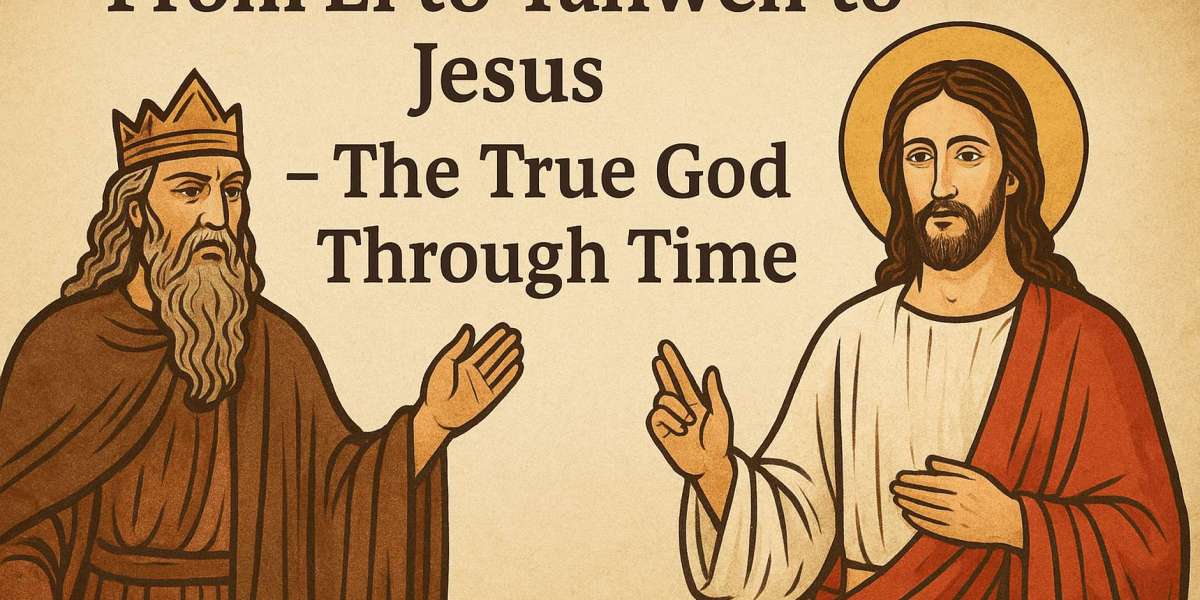1. The Ancient Confusion About “El”
Long before the Bible was written, the peoples of the Middle East worshiped many gods. In Canaan and Ugarit, the chief deity was called El, meaning “mighty one.” He ruled a family of other gods such as Baal and Asherah.
When the early Israelites began to follow the Lord, they lived among these cultures. They used the same word El or Elohim to describe their God because that was the language everyone spoke.
But the God of Israel was different from the start. While Canaanites thought of El as a distant sky-father, the Israelites knew a God who acted in history—a God who rescued slaves from Egypt, guided them through the desert, and demanded justice, mercy, and holiness. This God was not one of many. He was the living Creator who entered human life.
---
2. Was Yahweh Just Another Canaanite God?
Some YouTube or online teachers claim Yahweh was a local mountain or storm god who later took El’s place. Historical evidence does not support that idea.
Archaeology shows that Yahweh’s name (YHWH) does not appear among the Canaanite gods. Inscriptions from places like Kuntillet Ajrud mention “Yahweh of Samaria” or “Yahweh of Teman,” proving His worship was unique.
Early Israelites may have described Him using familiar cultural words, but they quickly learned that Yahweh was not part of any pantheon. He created heaven and earth, ruled nations, and refused to share His glory with idols. Over centuries, through prophets and Scripture, God corrected human misunderstanding and revealed that He alone is God.
---
3. The Divine Council in the Bible
Psalm 82 paints a mysterious picture:
> “God stands in the divine council; He judges among the gods.”
At first glance it sounds like many gods meeting together. In reality, the psalm uses ancient imagery to show God’s supreme authority over spiritual beings. These “gods” are not equals; they are heavenly servants—what the New Testament later calls angels or powers.
When these powers became corrupt, Psalm 82 shows God judging them:
> “You are gods, sons of the Most High, but you will die like men.”
This is the moment where God reclaims the nations for Himself. It’s poetic language for Yahweh saying, “No one else will rule My creation; I alone will judge the earth.”
---
4. Deuteronomy 32 and the Nations
Deuteronomy 32:8–9 (based on the oldest Hebrew and Greek texts) explains that when God divided humanity into nations, He assigned them to the “sons of God,” but kept Israel as His own portion. Over time, many of those spiritual rulers misled people into idolatry.
That background makes sense of Psalm 82—God calls those rulers to account and takes back every nation. From this point, Israel’s prophets begin shouting the truth:
> “I am the Lord, and there is no other.” — Isaiah 45:5
This is the birth of true monotheism—the understanding that Yahweh was never a tribal god among others but the one and only Creator.
---
5. Jesus Fulfills the Revelation
When Jesus arrives, He completes the story. The same God who spoke to Moses now walks among humanity. He forgives sins, calms storms, and commands angels.
He says plainly,
> “Before Abraham was born, I am.” — John 8:58
That “I AM” echoes God’s name in Exodus 3:14. Jesus is not a new deity; He is Yahweh revealed in flesh.
At the Cross, Scripture says He disarmed the powers and authorities (Colossians 2:15). The spiritual rebels from Psalm 82 lose all power. After the Resurrection, Jesus declares:
> “All authority in heaven and on earth has been given to Me.” — Matthew 28:18
The old divine council is replaced by one Lord and His redeemed people.
---
6. Revelation—The End of the Story
In the Book of Revelation, the same pattern appears but now perfected.
The heavenly throne scene (Revelation 4–5) shows one throne and one Lamb.
The “dragon,” “beast,” and “false prophet” represent the final rebellion of those fallen powers.
When Christ returns, He destroys them, fulfilling Psalm 82’s cry:
> “Arise, O God, judge the earth!”
Finally, the nations that once followed false gods become the kingdom of our Lord and of His Christ (Revelation 11:15).
The divine council that once consisted of heavenly beings is now made up of the saints, believers redeemed by Jesus, reigning with Him forever (Revelation 5:10).
The story that began with El and many gods ends with one throne, one kingdom, one God—Father, Son, and Holy Spirit.
---
7. What This Means for Us
God’s revelation wasn’t sudden; it was a patient unfolding across history.
Humanity started with partial light: many gods, many myths.
Through Israel, God revealed His name: Yahweh, the “I AM.”
In Jesus, that name took human form: God with us.
Through the Spirit, that same God now lives within His people until the end of time.
The confusion of “El” and the divine council was never about multiple true gods. It was the stage through which the one true God made Himself known—first to Israel, then to the world, and finally through Christ to all creation.
---
Frequently Asked Questions
1. Is “El” the same as Yahweh?
No. “El” was a common word for “god” in ancient languages. Israel used it as a title, but Yahweh is the personal name of the one true Creator.
2. Did the Bible borrow ideas from Canaanite religion?
The Bible used familiar language so people could understand, but its message was radically different: God is holy, just, and the only source of life.
3. What happened to the “other gods”?
They were either imaginary idols or rebellious spiritual beings judged by God. Jesus’ victory on the Cross ended their rule.
4. Why does Psalm 82 sound polytheistic?
It’s poetic imagery showing God’s courtroom where He judges lesser beings—not a literal pantheon of equal gods.
5. How is Jesus connected to Yahweh?
Jesus is Yahweh revealed in human form—the same God who spoke to Moses now seen face to face.
6. What about the Holy Spirit?
The Spirit is God’s own presence working within believers, continuing the same divine life revealed in Jesus.
7. What does Revelation prove?
It shows the final fulfillment of Psalm 82: all false powers fall, and Jesus reigns forever as Lord of heaven and earth.








